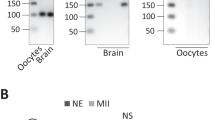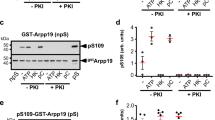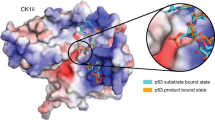Abstract
Full-grown Xenopus oocytes arrest at the G2/M border of meiosis I. Progesterone breaks this arrest, leading to the resumption of the meiotic cell cycles and maturation of the oocyte into a fertilizable egg. In these oocytes, progesterone interacts with an unidentified surface-associated receptor, which induces a non-transcriptional signalling pathway that stimulates the translation of dormant c-mos messenger RNA. Mos, a mitogen-activated protein (MAP) kinase kinase kinase, indirectly activates MAP kinase, which in turn leads to oocyte maturation. The translational recruitment of c- mos and several other mRNAs is regulated by cytoplasmic polyadenylation, a process that requires two 3′ untranslated regions, the cytoplasmic polyadenylation element (CPE) and the polyadenylation hexanucleotide AAUAAA1,2,3,4. Although the signalling events that trigger c-mos mRNA polyadenylation and translation are unclear, they probably involve the activation of CPEB, the CPE binding factor5,6. Here we show that an early site-specific phosphorylation of CPEB is essential for the polyadenylation of c-mos mRNA and its subsequent translation, and for oocyte maturation. In addition, we show that this selective, early phosphorylation of CPEB is catalysed by Eg2, a member of the Aurora family of serine/threonine protein kinases.
This is a preview of subscription content, access via your institution
Access options
Subscribe to this journal
Receive 51 print issues and online access
$199.00 per year
only $3.90 per issue
Buy this article
- Purchase on Springer Link
- Instant access to full article PDF
Prices may be subject to local taxes which are calculated during checkout




Similar content being viewed by others
References
Hake, L. E. & Richter, J. D. Translational regulation of maternal mRNA. Biochim. Biophys. Acta 1332, M31– M38 (1997).
Fox, C. A., Sheets, M. D., Wahle, E. & Wickens, M. P. Polyadenylation of maternal mRNA during oocyte maturation: poly(A) addition in vitro requires a regulated RNA binding activity and a poly(A) polymerase. EMBO J. 11, 5021–5032 ( 1992).
McGrew, L. L., Dworkin-Rastl, E., Dworkin, M. B. & Richter, J. D. Poly(A) elongation during Xenopus oocyte maturation is required for translational recruitment and is mediated by a short sequence element. Gene Dev. 3, 803–815 ( 1989).
McGrew, L. L. & Richter, J. D. Translational control by cytoplasmic polyadenylation during Xenopus oocyte maturation: characterization of cis and trans elements and regulation by cyclin/MPF. EMBO J. 9, 3743–3751 ( 1990).
Hake, L. E. & Richter, J. D. CPEB is a specificity factor that mediates cytoplasmic polyadenylation during Xenopus oocyte maturation. Cell 79, 617–627 (1994).
Stebbins-Boaz, B., Hake, L. E. & Richter, J. D. CPEB controls the cytoplasmic polyadenylation of cyclin, Cdk2 and c-mos mRNAs and is necessary for oocyte maturation in Xenopus. EMBO J. 15, 2582– 2592 (1996).
Paris, J., Swenson, K., Piwnica-Worms, H. & Richter, J. D. Maturation-specific polyadenylation: in vitro activation by p34 cdc2 and phosphorylation of a 58-kD CPE-binding protein. Genes Dev. 5, 1697–1708 (1991).
De Moor, C. H. & Richter, J. D. The mos pathway regulates cytoplasmic polyadenylation in Xenopus oocytes. Mol. Cell. Biol. 17, 6419–6426 ( 1997).
Ballantyne, S., Daniel, D. L. Jr & Wickens, M. A dependent pathway of cytoplasmic polyadenylation reactions linked to cell cycle control by c-mos and CDK1 activation. Mol. Biol. Cell 8, 1633– 1648 (1997).
Katsu, Y., Minshall, N., Nagahama, Y. & Standart, N. Ca2+ is required for phosphorylation of clam p82/CPEB in vitro: implications for dual and independent roles of MAP and Cdc2 kinases. Dev. Biol. 209, 186–199 (1999).
De Moor, C. H. & Richter, J. D. Cytoplasmic polyadenylation elements mediate masking and unmasking of cyclin B1 mRNA. EMBO J. 18, 2294–2303 (1999).
Andresson, T. & Ruderman, J. V. The kinase Eg2 is a component of the Xenopus oocyte progesterone-activated signaling pathway. EMBO J. 17, 5627–5637 ( 1998).
Glover, D. M., Leibowitz, M. H., McLean, D. A. & Parry, H. Mutations in aurora prevent centrosome separation leading to the formation of monopolar spindles. Cell 81, 95– 105 (1995).
Francisco, L., Wang, W. & Chan, C. S. Type 1 protein phosphatase acts in opposition to Ipl-1 protein kinase in regulating yeast chromosome segregation. Mol. Cell Biol. 14, 4731–4740 (1994).
Bischoff, J. R. et al. A homologue of Drosophila aurora kinase is oncogenic and amplified in human colorectal cancers. EMBO J. 17, 3052–3065 (1998).
Zhou, H. et al. Tumour amplified kinase STK15/BTAK induces centrosome amplification, aneuploidy and transformation. Nature Genet. 20, 189–193 (1998).
Sen, S., Zhou, H. & White, R. A. A putative serine/threonine kinase encoding gene BTAK on chromosome 20q13 is amplified and overexpressed in human breast cancer cell lines. Oncogene 14, 2195– 2200 (1997).
Tatsuka, M. et al. Multinuclearity and increased ploidy caused by overexpression of the aurora- and Ipl1-like midbody-associated protein mitotic kinase in human cancer cells. Cancer Res. 58, 4811 –4816 (1998).
Giet, R., Uzbekov, R., Cubizolles, F., Le Guellec, K. & Prigent, C. The Xenopus laevis Aurora-related protein kinase pEg2 associates with and phosphorylates the kinesin-related protein XIEg5. J. Biol. Chem. 274, 15005 –15013 (1999).
Hake, L. E., Mendez, R. & Richter, J. D. Specificity of RNA binding by CPEB: Requirement for RNA recognition motifs and a novel zinc finger. Mol. Cell. Biol. 18, 685–693 ( 1998).
Bilger, A., Fox, C. A., Wahle, E. & Wickens, M. Nuclear polyadenylation factors recognize cytoplasmic polyadenylation elements. Genes Dev. 8, 1106–1116 ( 1994).
Dickson, K. S., Bilger, A., Ballantyne, S. & Wickens, M.P. The cleavage and polyadenylation specificity factor in Xenopus laevis oocytes is a cytoplasmic factor involved in regulated polyadenylation. Mol. Cell. Biol. 19, 5707–5717 (1999).
Stebbins-Boaz, B., Cao, Q., de Moor, C. H., Mendez, R. & Richter, J. D. Maskin is a CPEB associated factor that transiently interacts with eIF-4E. Mol. Cell 4, 1017 –1027 (1999).
Boyle, W. J., van der Geer, P. & Hunter, T. Phosphopeptide mapping and phosphoamino acid analysis by two-dimensional separation on thin-layer cellulose plates. Methods Enzymol. 201, 110–149 (1991).
Acknowledgements
We thank E. J. Luna for her help with the two-dimensional separation of phospho-peptides, J. Leszyk for amino-acid sequencing, and the W. M. Keck Foundation for support of the Protein Chemistry Facility. We also thank M. Fernandez and members of the Richter laboratory for discussions and critically reading the manuscript. R.M. was supported by a Leukemia Society of America Special Fellow Award and L.E.L. was supported by a National Science Foundation Predoctoral Fellowship. This work was supported by grants from the NIH (to J.V.R. and J.D.R.).
Author information
Authors and Affiliations
Corresponding author
Rights and permissions
About this article
Cite this article
Mendez, R., Hake, L., Andresson, T. et al. Phosphorylation of CPE binding factor by Eg2 regulates translation of c-mos mRNA. Nature 404, 302–307 (2000). https://doi.org/10.1038/35005126
Received:
Accepted:
Issue Date:
DOI: https://doi.org/10.1038/35005126
This article is cited by
-
Comparative analyses of vertebrate CPEB proteins define two subfamilies with coordinated yet distinct functions in post-transcriptional gene regulation
Genome Biology (2022)
-
The RNA-binding protein DAZL functions as repressor and activator of mRNA translation during oocyte maturation
Nature Communications (2020)
-
Crosstalk Between Angiogenesis and Fibrogenesis in Liver Disease
Current Tissue Microenvironment Reports (2020)
-
Musashi 1 regulates the timing and extent of meiotic mRNA translational activation by promoting the use of specific CPEs
Nature Structural & Molecular Biology (2017)
-
Dueling RNA-binding proteins promote translational activation
Nature Structural & Molecular Biology (2017)
Comments
By submitting a comment you agree to abide by our Terms and Community Guidelines. If you find something abusive or that does not comply with our terms or guidelines please flag it as inappropriate.



